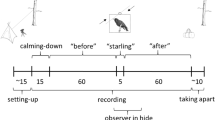Summary
A graphical model presented here indicates that a nest-defending forager should stay closer to its nest, forage for shorter times per patch, and deliver smaller loads than predicated for delivery rate maximization. The effect is more pronounced farther from the nest, so that if nest defense is especially important, the predator should leave far patches sooner than near ones, and deliver smaller loads from farther away. Moreover, if the attack rate at the nest is increased, the defending forager should move closer and deliver smaller prey.
Experimental attacks with stuffed specimens at Gila woodpecker (Melanerpes uropygialis) nests produced the predicted changes in the foraging behavior of males, but not of females.
Mated pairs may work as a team to pursue simultaneously two conflicting goals—food delivery and nest protection—both of which affect the survivorship of the young. Sexual dimorphism in monogamous species may result in part from specialization in these roles.
Similar content being viewed by others
References
Andersson M (1978) Optimal foraging area: size and allocation of search effort. Theor Popul Biol 13:397–409
Caraco T (1979) Time budgeting and group size: a theory. Ecology 60:611–617
Covich AP (1976) Analyzing shapes of foraging areas: some ecological and economic theories. Annu Rev Ecol Syst 7:235–257
Keeney RL, Raiffa H (1976) Decisions with multiple objectives: preferences and value tradeoffs. Wiley, New York
Martindale S (1980) Foraging patterns of nesting Gila wood-peckers. PhD dissertation, University of Arizona
McCleery RH (1978) Optimal behavior sequences and decision making. In: Krebs JR, Davies NB (eds) Behavioural ecology, an evolutionary approach. Sinauer, Sunderland, MA
Orians GH, Pearson NE (1979) On the theory of central place foraging. In: Horn DJ, Staris GR, Mitchell RD (eds) Analysis of ecological systems. Ohio State University Press, Columbus, OH
Rosenzweig ML (1974) On the optimal aboveground activity of bannertail kangaroo rats. J Mammal 55:193–199
Schoener TW (1979) Generality of the size-distance relation in models of optimal foraging. Am Nat 114:902–914
Skutch AF (1976) Parent birds and their young. University of Texas Press, Austin, TX
Snyder NFR, Wiley JW (1976) Sexual dimorphism in hawks and owls of North America. Ornithol Monogr 20:1–96
Author information
Authors and Affiliations
Rights and permissions
About this article
Cite this article
Martindale, S. Nest defense and central place foraging: A model and experiment. Behav Ecol Sociobiol 10, 85–89 (1982). https://doi.org/10.1007/BF00300167
Received:
Accepted:
Issue Date:
DOI: https://doi.org/10.1007/BF00300167




